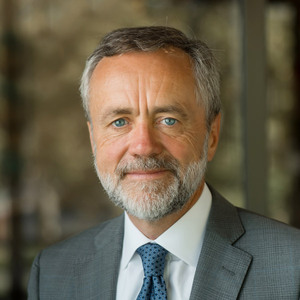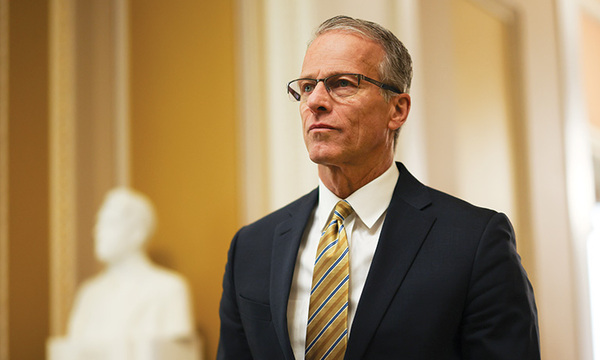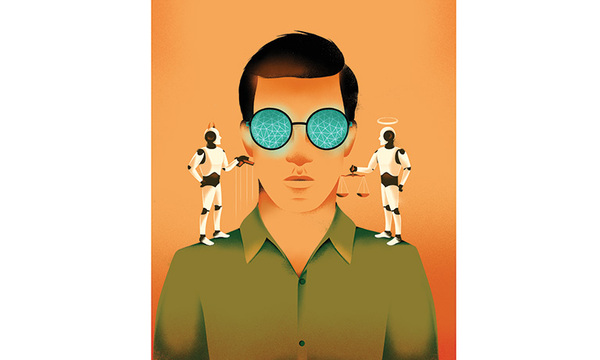
Biola University’s mural, "The Word," has for 20 years stretched from top to bottom of Bardwell Hall, our science building. Painted by renowned Los Angeles muralist Kent Twitchell, this mural is one of many in his repertoire of bigger-than-life outdoor art, from Philadelphia’s "Dr. J." to a Southern California freeway underpass.
Kent was back at Biola this summer restoring "The Word" to its original condition.
Because this singular piece of art is the largest and most dominant on Biola’s campus, it has elicited a wide array of responses and has stimulated many discussions. Art, by its nature, provokes. It reflects tensions. It demands from us a response, and inevitably those responses vary. Art calls us to a deeper way of thinking and pondering. When art fails to stretch us in new dimensions to understand God’s truth and beauty, it has fallen short of its purpose.
Thinking biblically, or theologically, calls us to a more robust appreciation of the arts. Theology is complicated, and sometimes profound articulations of it come through art. The arts excel at making sense of the big, messy, incomprehensible world, and likewise, they are uniquely equipped to explore and encounter the intricacies and nuances of Christian theology.
This is not to say that art, poetry, photography or film says something directly theological. We need to create in a way that is true to our experience and our identity as children of a God who is himself a creator — a God who created a world that he said was “good,” but which now groans for restoration to that goodness that has fallen away as a result of sin, as Paul writes in Romans 8.
Christian art serves its theological purpose when it embodies this “in between” state — between a perfect, unblemished creation on one side and a restored, new creation on the other. We are between two perfections, and yet in our imperfect landscape there are glimpses of incomprehensible beauty that must be some sort of remembrance or longing for that which we know exists — that for which we were ultimately created.
As parts of the body of Christ, we recognize that the kingdom of God exists in a curious “now and not yet” place. New Testament theologian George Ladd helps us understand the tension between this present evil age brought about by the fall of man and the reality that Jesus reigns and the Kingdom of God is present now. We are the mirrors reflecting it to the world. But the kingdom is also still to come. It’s a future glory that everything longs for and looks toward.
Art is at its best when it has tension, because we live in a “now and not yet” world.
Music requires minor chords or dissonant themes before it can resolve. Films are constantly putting roadblocks in the protagonist’s path to redemption. The play of light and dark in a painting, the jolting rhythms of a poem, the haunting absences of a photograph. So much of this in art is about tension.
The Christian liberal arts education offers us a particularly strong framework from which we can create meaningful art that lives in this tension. The liberal arts help us broaden our perspectives, question things, wrestle with them in ways that are neither shallow nor simplistic.
This Year of the Arts at Biola will help us focus on God, bringing together an interdisciplinary array of artists and thinkers. It’s an opportunity for us to understand better what “practicing theology” looks like in the world of aesthetics. It’s an opportunity for us to wrestle with the theological meaning of making art and culture. It’s an opportunity for us as a community of believers to think about how art helps us get through this “now and not yet” world.
As we begin the 2011–12 fall semester and welcome 6,000-plus students to a new academic year, we do this in celebration of the arts. On page 22 of Biola Magazine is a programmatic overview of Biola University’s Year of the Arts. My desire is that our community’s perspective on God’s truth and on the nature of the beauty that he created will enrich and delight us. Not for our sake, of course, but to bring glory to the Lord.
Barry H. Corey is the president of Biola University. Visit his office online at www.biola.edu/president, on Facebook at facebook.com/presidentcorey and on Twitter at twitter.com/presidentcorey.
 Biola University
Biola University



